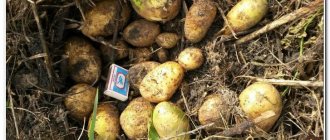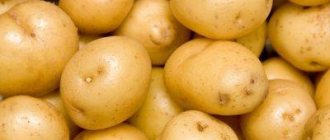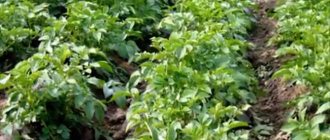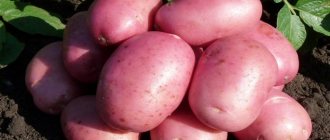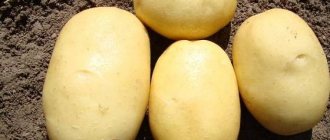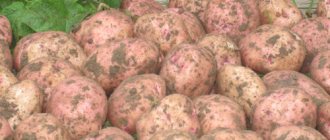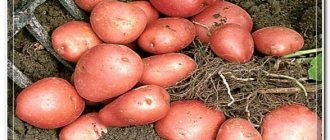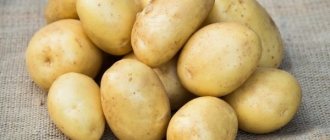Potatoes “Evolution” - description of the variety, photos, reviews My family cannot live without potatoes for a day. We plant a plantation every time, as if we were going to feed an army, but we can’t make it to the next harvest. You have to buy more at the beginning of summer.
However, in the store it’s not tasty, and in the market it’s expensive. So we are sitting on the suction. Last year I tried to plant Evolution potatoes. I was looking for an early one, but I read the description of the variety, it says mid-season. But I really liked his photos and reviews.
They started digging for food in early July, and the tubers were already big. Maybe they imprisoned him early because, I don’t know. But the main thing is that now you don’t have to run and bribe. We'll hold out for a month.
Characteristics of the variety
General characteristics: mid-early table potato variety of Dutch intensive selection with large, elongated oval tubers. Resistant to mechanical damage. Mainly used for early potato harvest. Adapts to soil and climate. Due to its difficulty in care, it is considered a variety for professional potato growers.
- Ripening period (vegetation): 65-85 days.
- Starch content: 16-18.7%.
- Weight of commercial tubers (grams): 70-140.
- Number of tubers in a bush: 9-15 pieces.
- Productivity (c/ha): 420-590.
- Consumer qualities: low boilability, culinary type (AB), suitable for preparing salads, soups and fried potatoes.
- Keeping quality (storage ability): 94% (short rest period).
- Peel color: red.
- Flesh color: light yellow.
- Preferred growing regions (RF): any soil and climate (sandy soil recommended).
- Disease resistance: the variety is resistant to potato nematode and late blight of tubers, moderately resistant to Yntn virus and scab, and is affected by late blight of tops.
Features of cultivation: germination is not necessary, a reduced rate of nitrogen fertilizers is desirable, the highest yield is on sandy soils. Tubers tend to germinate quickly; it is recommended to store seed at low temperatures. Highly sensitive to zencor. Planting rate is 45,000 plants per 1 hectare (35x55 mm). During the dry season, watering is required.
Evolution potatoes are of Dutch origin. It was brought out at the end of the 20th century. Literally a year later, this variety gained recognition throughout the world and was included in the National Register of the Russian Federation.
This type of root crop is suitable for any region. Any soil is suitable for growing it, as long as it has a low acid content. Climatic conditions do not affect the development of this variety.
The characteristic of the Evolution potato variety is that it is mid-early. The growing season is about 80 days. The stem is quite tall and spreading. Side shoots may fall apart under heavy stress. The stem bears a large amount of foliage, which has a dark green tint. There is a ribbed surface along the edges of the leaves of the plant.
At the top of the bush you can see an inflorescence presented in purple. About 4 inflorescences can form on one bush. The only caveat is that the flowers fall off quite quickly.
kartofan.org
Description
general characteristics
Evolution potatoes are a mid-season table variety, fully ripening approximately 65-85 days (depending on the weather and region) after planting. It is one of the yellow-fruited, high-yielding varieties. The variety has been tested in Russia and is included in the Register of Varieties and Hybrids.
Attention!
Due to its growing characteristics and care and watering requirements, the Evolution variety is considered a variety more suitable for professional potato growers than for ordinary gardeners.
Appearance
Escapes
Bushes of the Evolution variety are erect and spreading - this must be kept in mind when planning planting and carrying out hilling. The height of the tops reaches about 70 cm. The leaves are large, bright or dark green (depending on growing conditions), their edges have a pronounced waviness.
When flowering, it forms purple inflorescences (on average about 4 per bush). Flower petals quickly fall off, forming an ovary of berries.
Roots
Evolution potatoes have round-shaped tubers, on average from 9 to 15 per bush. The peel is yellowish-red, smooth. The eyes are small and smooth, which makes cleaning easier, including mechanical cleaning. When cut, the pulp of the tubers has a distinct yellow color.
Photo
Below are photos:
Seeding rate and yield per 1 hectare
When planting Evolution potatoes, you should usually proceed from a norm of about 45,000 tubers per 1 hectare. In this case, the total mass of seed material will depend on the size of the tubers that will be used for planting: the larger they are, the usually greater the yield, but also the higher the consumption. On average, 1 hectare of industrial cultivation requires from 28 to 35 centners of potatoes.
If the variety is planted manually in a small area, the planting rate can be reduced. Approximately 20-25 kg of seed tubers of the Evolution variety are consumed per 1 hectare.
The Evolution variety has good yield: from 420 to 590 c/ha. In some cases, mainly in the North-Western agricultural region, in tests it was possible to obtain record yields of over 600 c/ha.
Taste qualities
Although yellow-fleshed potatoes originate from fodder varieties and not table varieties, during selection all the shortcomings in taste were corrected. The modern Evolution variety has good taste characteristics and can be used for preparing any dishes.
Chemical composition
The most important indicator for potatoes in terms of chemical composition is the starch content.
The Evolution variety is “average” in this regard: in it this figure ranges from 15 to 18.7%. In addition to starch, tubers contain significant amounts of sugar and ascorbic acid. The amount of microelements varies greatly depending on the composition of the soil and the type of fertilizer used.
Average tuber weight
When grown, Evolution potatoes produce tubers weighing from 80 to 150 g. The variety is not prone to producing record-breakingly large potatoes even in soft, fertile soils.
Marketability
The number of marketable tubers for Evolution ranges from 90 to 95% of the total harvest weight. This is a normal indicator for mid-season varieties.
Resistance to diseases and pests
According to the entry in the Register of Varieties and Hybrids, the Evolution variety is recognized as resistant to golden nematode and potato blight. In tests, it showed high resistance to late blight of tubers, but the stems do not have immunity and are easily affected. Scab resistance is very good.
Keeping quality
For Evolution, keeping quality is 94%. However, the variety has a short dormant period, so it should only be stored at low temperatures. This factor, however, also has a positive side: when planting, the Evolution variety can easily do without germination.
Evolution potatoes are quite difficult to boil, so it is better to use them for frying or preparing salads. Can also be used for the production of chips or dry potato powder. The variety is of little use for processing into starch or alcohol.
Description of the fruit
The description of potatoes states that the fruits have equal shape and weight. The weight of the fruit can reach 150 g. Their shape is oval and has smooth edges. The peel is presented in a red hue. On the upper part of the peel there is a small number of depressions, of medium size. One bush can contain about 1 potato.
When cut, the flesh appears in a warm yellow hue. It is quite fragile, but does not become soft when cooked. The starch level is quite high at 19%. This is a very good parameter, because the taste improves. Another characteristic of the Evolution potato variety is its versatility.
It is used to make soups, salads, mashed potatoes or even French fries.
Medium ripening varieties
This category includes types of potatoes that are harvested 60-75 days after planting. Each root vegetable contains a large amount of starch. Mid-season varieties are not afraid of sudden changes in temperature. Suitable for long-distance transportation and long-term winter storage.
Granada
Potatoes have a developed root system. The maximum number of fruits is 15 pieces. The weight of each varies from 90 to 180 g.
If Granada forms a small number of tubers, the weight reaches up to 250 g. The root crops are even and smooth, elongated. The light yellow flesh is covered with a thin yellow skin. After cutting it does not darken for a long time.
Granada's eyes are almost invisible and do not interfere with peeling.
Grandmother
The potato variety is resistant to the following diseases:
- ring rot;
- cancer;
- late blight;
- rhizoctoniasis.
Adapts to areas with any climate. Tolerates drought and heat, productivity remains unchanged over the years. Tubers form early, young potatoes are edible.
Arctic
Mid-season type of potato with beige-colored tubers. The shape of vegetables is a rounded oval. There are no more than 10 eyes on one potato. With a weight of 90 g, the starch level is only 12%.
Elena
Potatoes ripen on the 75th day. During the season, one bush produces 8-12 potatoes. The creamy flesh is covered with a red skin.
Zlatka
Large root vegetables with yellow flesh. During heat treatment, the vegetable softens and becomes tender in taste. Fully matures within 2 months.
The Colorado potato beetle does not often infect Zlatka bushes, preferring other varieties. Potatoes do not suffer from late blight. Long-term storage of fruits is acceptable.
Varangian
When you cut a potato, you can see white flesh, which is covered by a skin several shades darker. An adult bush produces from 5 to 9 fruits. Tubers weigh from 110 to 145 g.
Potatoes are oval-shaped, elongated. Varyag bears fruit well and produces a large harvest during the season. The eyes are located on the surface of the potato and are small.
Epic of Siberia
The Bylina of Siberia variety is a bright “potato” representative, part of the group of root crops of medium ripening. Sustained drought does not affect crop yields. The color of the peel and pulp is the same - rich yellow. Tubers are suitable for first hot courses, main courses, as well as for creating various light snacks.
Positive and negative aspects of the variety
Dutch breeders have used many years of experience to create a truly high-quality variety with a minimum number of shortcomings. And they did it well. Among the main advantages it should be noted:
- High shelf life - up to 94%.
- Good yield - up to 600 c/ha.
- Good taste.
- The versatility of tubers.
- Presence of superficial ocelli.
- Resistance to diseases and pests such as mosaic, potato cancer and nematode.
Along with that, there are several disadvantages. In particular:
- Evolution is difficult to tolerate drought and lack of watering. In unfavorable growing conditions it is very difficult to obtain a normal harvest.
- Not protected from late blight.
fermerss.ru
Advantages and disadvantages
The main advantages of the Evolution variety are:
- Good taste.
- High shelf life (subject to storage conditions).
- The yield is very good for mid-season varieties.
- Resistance to major pests.
- Peel resistance to mechanical damage.
But there are also disadvantages :
- The variety is very demanding on the amount of moisture in the soil. Both a lack and an excess of water during irrigation are equally bad for the crop.
- The variety is a new selection, and therefore has not yet become established. Because of this, rapid degeneration occurs during cultivation: in fact, new seed material must be purchased every 2-3 years.
- The tops are not resistant to late blight.
Soil requirements
Evolution potatoes can be successfully grown in any type of soil with a low alkaline content. It is not recommended to plant this variety in soil that is too acidic, as this will negatively affect the root system of plants and significantly reduce fruit yield.
To prepare the soil on the site for planting potatoes, you must perform the following steps:
- remove all last year’s plant remains and dig up the soil on the site;
- apply complex fertilizers containing phosphorus, potassium and magnesium;
- loosen the soil before planting.
The highest yields of Evolution potatoes are achieved when grown in loose sandy soil.
Characteristics of Evolution potatoes
Under favorable weather conditions, the bushy part is high (up to 70 cm), the stems themselves are erect, the bush is moderately branched, with large bright green leaves. The corollas of the flowers are purple, the color intensity is strong, the size of the corolla is large.
Bright anthocyanin color of the corolla
On a note. The variety is mid-season, frost-resistant. Optimal for cultivation in such regions of Russia as Volga-Vyatka, Ural, North-West, Moscow, Moscow region.
The tubers of the plant have an oval oblong shape, their color is rich, brownish-red. The color of the pulp when cut is yellowish. The potato eye is small, which makes the peeling process much easier. The taste is excellent; for lovers of such dishes as fried potatoes, this is simply a godsend.
The weight of one tuber is on average 80-150 grams, they are smooth and have an attractive presentation. Starch concentration: varietal potatoes contain on average 15-18% starchy substances. This is considered a rather low indicator, which is at the same time an advantage - such a product is more valued by chefs.
Pulp on the cut
The yield is up to 500-600 c/ha, with proper fertilization, as well as timely destruction of weeds that interfere with the normal growth of the plant. This parameter also depends on how carefully the occurrence of plant diseases such as late blight and scab is carried out on the land plot; It is imperative to destroy the Colorado potato beetle in a timely manner.
Note! A varietal feature is the presence of a large number of tubers: from one bush you can get up to 20 large potatoes, and sometimes up to 25. The Evolution potato variety gives the highest yield while maintaining planting density: the distance between the centers of the holes should be approximately 35x50 cm.
Preparation of planting material
Evolution potato seed tubers are distinguished by the fact that they are able to quickly germinate in the ground, so there is no need to germinate them before planting. All you need to do is follow these simple steps:
- select smooth, medium-sized tubers for planting, up to 7 cm long;
- planting material should not have mechanical damage, rot or growths;
- treat the tubers with a fungicide to protect future plants from bacterial and fungal infections.
farmer.blog
Correct fit
Feedback from gardeners suggests that if you make mistakes at the planting stage, you will not be able to get a good harvest. Planting potatoes correctly is not just about burying them in the ground.
First of all, you need to select high-quality planting material. These should be small root crops 60-70 cm without any visible defects (the presence of rot, cracks, ulcers, growths, spots, etc.).
Tubers begin to be planted only when the soil warms up to +8 degrees Celsius. This period approximately occurs in early to mid-May. Also, you can navigate the old fashioned way: “When the birch tree begins to put out its leaves, then the potatoes are ready for planting.”
Standard landing pattern:
- We make row spacing at least 60-70 cm. Such a large distance is necessary so that the bushes receive a sufficient amount of sunlight and are well ventilated. Also, a larger distance will make hilling easier.
- Leave at least 30 cm between bushes.
- Approximately 20-25 kg of Evolution planting potatoes will be needed per 100 m2.
fermerss.ru
Landing Features
Obtaining a good harvest depends on whether a number of rules are followed, in particular, whether the planting dates are met, whether the soil is prepared and whether the planting material is selected of high quality.
Landing dates
Previously, before planting potatoes, people paid attention to the birch tree. If the leaves on this tree began to open, this indicated that the weather conditions were favorable for planting the crop.
In general, potatoes begin to be planted from the beginning of May. The required soil temperature for planting is +9-10 C, the air temperature is about +13-15 C.
Site preparation
Lorch potatoes need to be grown in well-ventilated and illuminated areas. Any shadow will reduce the productivity of the bush.
Lorch is not picky about the type of soil. But still, potatoes grow ideally on loamy and sandy loam soils
Also, special attention should be paid to the density of the soil. The denser the soil, the worse the tubers will develop; the looser it is, the better.
The soil is prepared long before planting, in the fall. For this:
- The area is cleaned, removing weeds and crop residues.
- Fertilizers are applied. It is advisable to use humus at a rate of 4 kg per 1 m2.
- The fertilized soil is dug up to a depth of at least 15 cm. We do not break up the piles. They help retain snow, which will allow the soil to be saturated with moisture in the spring.
Planting scheme
Lorch is a spreading plant. When planting this variety, maintain 35 cm between holes and 70 cm between rows. This distance will allow the crop to be well ventilated and illuminated. Also, the hilling process will be significantly simplified.
The tuber planting depth is 10 cm. This is if the soil is good. In heavy soils, root crops are placed closer to the surface, at a depth of no more than 8 cm.
Plant care
Evolution potatoes have no special preferences regarding care. They should be cared for as you would most other root vegetable varieties.
Firstly, regular feeding of the bush is important. Organic substances are used for this. Preference should be given to droppings, humus or wood ash.
Secondly, it is important not to forget to hill up the rows so that the root system is always covered. It is also recommended to regularly remove weeds and loosen the soil. This is done so that the plant receives more oxygen.
The third factor is proper watering. In places where the climate is temperate, watering is carried out quite rarely. But at high air temperatures, watering is carried out as the soil dries.
fermoved.ru
Irrigation
Potato Evolution is very responsive to watering. But this does not mean that they should be neglected. Taking into account the variety’s need for water, the following irrigation scheme can be used:
- The first time is 3 weeks after the first shoots appear. Gardeners do not recommend earlier watering.
- The second time before/or immediately after flowering.
- The third time is in the peak flowering phase.
- The fourth time before the end of flowering or immediately after it.
- If there is a terrible drought and there is no precipitation, then the amount of watering can be increased.
Also, experienced gardeners do not recommend watering the crop after flowering. During this period, the potato enters the “ripening” phase, its immunity becomes weaker and more vulnerable to late blight. And for this fungus, moisture is an ideal environment for development.
Hilling
Thanks to hilling, it is possible to create additional stolons, which on average increase the yield of Evolution potatoes by 20-30%.
In addition, when hilling:
- The area is cleared of weeds. This allows the crop to grow “out of competition”, receiving nutrients from the soil in full.
- The soil is loosening. It is enriched with oxygen, which the culture needs for normal development.
- Potatoes are hilled twice a season: the first time when the tops grow to 20 cm, the second time 2-3 weeks after the first time.
Diseases and pests
The variety is vulnerable to diseases such as scab and late blight.
When scab occurs, ulcers form on the surfaces of root crops. The cause of scab development is high temperatures and lack of moisture. This disease is treated with acidic fertilizers, which contain ammonium sulfate and manganese sulfate.
To prevent Arizona potatoes from encountering scab, you need to carry out prevention:
- choose only high-quality planting material;
- systematically water the crop;
- spud;
- mulch the soil.
With late blight, the lower leaves of the tops begin to darken and gradually spread to the entire above-ground part. Subsequently, the tubers begin to die.
Why does late blight appear? Main reasons:
- too dense planting;
- infected planting material;
- excess moisture.
To treat late blight, Reglon super and similar fungicides are used.
Preventive measures include normal watering and timely loosening of the soil.
Lyudmila Mikhailovna, 35 years old, Irkutsk.
I liked the variety beyond belief. Seriously, I have never experienced such emotions while harvesting. The tubers are huge, the harvest is huge. The disadvantage, of course, is that it ripens too late, but it is stored longer than any early varieties. They grew it on fertile soil, constantly watered it, I hilled it 3 times. Our site is always clean, there are no weeds or parasites, except for Colorado potato beetles. But even in such conditions, not all varieties showed good results, but Arizona seriously pleased. The Dutch did a good job.
Nikolai Ivanovich, 46 years old, Stakhanov.
I grow potatoes for planting. Favorite varieties include Scarb, Vega and Arizona. Favorite because they go off with a bang on the market. There are regular customers who only buy potatoes from me. Arizona is a productive and large variety. It's very rare to eat change. In terms of cultivation, it is responsive to fertilizing and watering.
Vladislava Viktorovna, 51 years old, Rostov.
Arizona is a good variety. We started growing it several years ago, so far there are no problems. It is always affected by the Colorado potato beetle, although our neighbors have other varieties, and these beetles also gnaw on them. There have not been enough other diseases so far. The taste is good, sweetish. We use it everywhere, be it some kind of salad or soup.
Egor Mikhailovich, Shakhty, 31 years old.
A complete kettle in gardening. I planted potatoes, watered them, weeded them several times and am digging up the crop. My wife is from the city, and you can’t even drag her into the garden with a tractor. But he eats potatoes better than me. What's the result? In my opinion, this is an excellent harvest, considering the minimum effort I put into growing Arizona.
Diseases and parasites
This variety is quite resistant to most diseases. For example, it is not subject to diseases such as nematode, potato late blight or scab.
But, this variety may be exposed to late blight of the plant part, so preventive measures should be taken.
First of all, the seed material is treated with drugs such as Fofatox. It will blunt the development of the disease and resist it throughout the entire growing season.
Also, do not forget about foliage treatment. Again, you can use this drug. But spraying is carried out a few days before watering.
fermoved.ru
About late blight
As noted above, Evolution potatoes are not protected from diseases such as late blight.
Late blight is one of the most insidious fungi that affects potatoes. Late blight can invade both tubers and the green part of the crop. The fungus spreads by spores, allowing it to quickly infect large areas.
Experienced gardeners recommend reacting immediately if a sign of infection by this fungus is noticed.
The ideal conditions for fungal growth are dampness. In hot weather, spore formation is very weak and the fungus hardly spreads.
Symptoms of late blight:
- The appearance of dark spots on the leaves.
- The appearance of dark spots on the stems, which over time acquire a brown tint.
- The appearance of a white coating (these are spores).
- The appearance of “rotten” spots on the tuber.
It is worth noting that late blight does not operate in the area where mustard is planted. Therefore, this can be one of the preventive measures to prevent infection with this fungus.
Basic measures to protect against late blight fungus:
- Using only high-quality planting material.
- Maintaining crop rotation.
- Protection of crops from waterlogging.
Weed removal
The key to successful potato growing is proper care of the soil around the plants. As a result of this, the bush quickly grows green mass, and after flowering it forms beautiful and large tubers. A list of soil care actions in potato beds is presented below.
Weeding is especially important during the period from the appearance of the first shoots to the beginning of flowering. Weeds need to be removed regularly, as they absorb moisture and nutrients from the soil and shade young potato sprouts, thereby preventing their growth.
Loosening the soil - it is recommended to carry out it after rain or watering to improve the air permeability of the soil. Hilling up plants helps to form a nest of tubers and has a beneficial effect on the condition of the root system of plants, prevents the growth of weeds and drying out of the soil.
The stems are hilled for the first time after they reach a height of 20 cm, and after 2–3 weeks this procedure is repeated; Mulching potato beds helps keep the soil moist and loose and prevents the appearance of weeds.
Tubers of the Evolution variety have a high tendency to germinate, so they need to be stored in a dark place.
farmer.blog
Characteristic
The Explosive potato variety has round or oval tubers. The tough skin is reddish-pink, with a warm palette of light tones. The eyes are medium-sized, small and of medium depth. The shades of the dense and juicy pulp are cream or yellowish. From 8 to 14 tubers are formed in the nest, almost identical in size. The average weight of the Vzryvny potato fruit, according to the description of the variety in official sources, is 110-150 g. The yield for early varieties is high, reaching up to 450-500 c/ha if the crop care requirements are met.
Note! The tubers are formed for harvesting after 42-50 days of plant development, which is a valuable feature of the Vzryvnoy variety. Full ripening occurs in 60-70 days
The early potato variety is responsive to timely enrichment of the soil with organic matter. Therefore, they plant the Explosion potato in a plot prepared in the fall, in which case it lives up to its glib name. The marketable yield of early ripening products is 93%, this is a very high figure, at the level of well-known foreign varieties
Full ripening occurs in 60-70 days. The early potato variety is responsive to timely enrichment of the soil with organic matter. Therefore, they plant the Explosion potato in a plot prepared in the fall, in which case it lives up to its glib name. The commercial yield of early ripening products is 93%, this is a very high figure, at the level of well-known foreign varieties.
Potato tubers Explosion with excellent taste, rich in starch, which is determined in the range from 16 to 22%
The content of this substance, important for the structure of cooked potatoes, depends on the availability of fertilizers and moisture:
- the larger the area with the crop was fed, the less starch, which cannot be formed quickly in early varieties;
- in the dry season, the tubers are much richer in starch than in the rainy summer.
Tubers of the Vzryv variety belong to the culinary type CD according to the international classification, which has the following characteristics:
- boilability;
- mealiness;
- lack of wateriness.
Thanks to their dense skin, varietal potato tubers are resistant to mechanical damage and are suitable for mechanized harvesting. They are well stored, their shelf life rises to 95%, which meets modern requirements for the quality of commercial products.
The shape of the tubers is round or oval
Although the variety was tested in areas of the Central region of Russia, in accordance with the official description of the Vzryv potato, it is suitable for cultivation in all areas where potatoes are planted. Another valuable feature of the variety is its high adaptability to any soil, as well as to climatic variations.
Important! The variety is drought-resistant and tolerates long periods without additional moisture, although with watering the yield increases significantly. The creators of the new variety of early potatoes took care to select plants that are resistant to a number of characteristic diseases:
The creators of the new variety of early potatoes took care to select plants that are resistant to a number of characteristic diseases:
- potato cancer;
- late blight of tubers and tops;
- common scab.
Note! The variety is susceptible to viral infections; gardeners should take note of this. Periodic phyto-cleaning of varietal plantings is recommended
A big plus for potato-growing summer residents is that the Vzryv variety resists infection with the golden cyst nematode
Periodic phyto-cleaning of varietal plantings is recommended. A big plus for potato-growing summer residents is that the Vzryv variety resists infection with the golden cyst nematode.
Harvest and storage
Evolution potatoes can be harvested at the end of August. You can dig up tubers manually or using special equipment. Basic harvesting guidelines are listed below:
- mow the tops 2 weeks before the start of tuber harvesting;
- It is best to dig up fruits in dry and warm weather;
- After harvesting, dry the tubers outside under a canopy for several days;
- sort fruits by size, separate seed material and discard spoiled or damaged fruits.
Evolution potatoes can be stored until the beginning of spring in a cool (no more than +2...+3°C) cellar or basement. Under such conditions, the shelf life of tubers is 94%.
Evolution potatoes are one of the best varieties that combine unpretentiousness to growing conditions and high yields.
Even novice farmers can plant this variety on their plots, since to get a good harvest of beautiful tubers, you just need to follow the simple recommendations listed above.
farmer.blog
Potatoes "Evolution" - description of the variety, photos, reviews and opinions
This is a very good variety, which is not in vain recognized as one of the best in the whole world. It does not require care and produces a good harvest. These options are perfect for those people who are just starting to work in farming.
- Elena Yurievna, Rostov, 54 years old.
I've never heard of this variety before. I accidentally saw a photo on the Internet and fell in love. I decided to find it at the market, but I couldn’t find it anywhere. I was lucky that my friends in the capital were able to buy seed potatoes, so I propagated them a little. What can I say? The variety is good, productive, and has not suffered from any disease. We watered it normally, the soil was black soil, we fertilized it often. The potatoes are very tasty and don’t get overcooked. - Dmitry Gennadievich, Kyiv, 49 years old.
In 2021 I bought Evolution, Riviera and Gala planting potatoes. All varieties 10 kg. As a result, I collected approximately 450 kg, 150 kg for each variety. Evolution and Riviera are huge, the tubers are as big as the palm of your hand, but Gala is like a chicken egg, but there are a lot of them in the bush. Everyone has good taste.
fermerss.ru dachadecor.ru
Origin story
Initially, the Evolution variety was bred in 2011 in the Netherlands by specialists (we also know other varieties in Russia - for example, “Picasso”, colloquially “Limonka”). Previously selected samples of mid-season potatoes cultivated in Europe were used as a basis.
In 2015, the variety was tested in Russia, and the State Variety Commission included it in the Register of Varieties and Hybrids Approved for Cultivation. Evolution is zoned almost throughout Russia - from the North-Western to the West Siberian region.
Secrets of growing a big harvest
Such a long period of growing potatoes did not bring experience to most gardeners. For most, the process of growing potatoes is completed by simply burying the tubers in the spring, rare hilling and collecting Colorado potato beetles. Tiring work with a hoe leaves no reason to think about dialectics - the transition from quantity to quality.
Meanwhile, if you apply in practice all the knowledge of mankind about growing potatoes, all the secrets and life hacks, then the potato yield will increase significantly, and the area occupied by plantings will decrease in proportion to the increase in experience.
I bring to your attention the main secrets of experienced potato growers, which are simple enough to use in an ordinary garden or summer cottage.
good-tips.pro
Disinfection of tubers intended for planting
Potato tubers intended for planting must be disinfected to prevent diseases and reduce the number of pests. Pests love to attack tubers in the spring, before potato sprouts germinate.
It is believed that adding boric acid to disinfectant solutions for potatoes stimulates shoot growth in the first days after planting in open ground.
Tubers are disinfected by soaking or spraying from a spray bottle. Soaking the tubers for two to three hours is most effective.
- Composition No. 1 “For disinfection”: 1 kg of crushed garlic is diluted in 10 liters of water, and then the potato tubers intended for planting are sprayed or soaked.
- Composition No. 2 “Nourishes and disinfects”: dissolve half a gram of potassium permanganate (potassium permanganate) in 10 liters of water, add 5 grams of copper sulfate and 15 grams of boric acid.
- Composition No. 3 “Superphosphate”: to obtain a disinfectant and nutrient solution, dilute 60 grams of superphosphate, 40 grams of urea, 5 grams of potassium permanganate in 10 liters of water and add 10 grams of boric acid.
- Composition No. 4 “For spraying tubers”: 15 grams of boric acid, 30 grams of potassium sulfate, 40 grams of urea, 1 gram of copper sulfate and half a gram of potassium permanganate are dissolved in 10 liters of water. The consumption rate of the composition is 1 liter per 100 kg of potatoes.
The tubers are sprayed until the sprouts sprout; if the tubers have sprouted, then the composition is diluted with water to half.
Soaking tubers before planting
Experienced potato growers soak the tubers for 2 days before planting in a nutrient solution. They say the yield increases up to 15%, germination and tuber formation are accelerated.
The recipe for a nutrient solution is simple: 40 grams of superphosphate, nitrogen fertilizers and potassium salt and dissolved in 10 liters of water.
The consumption rate of the nutrient solution is 10 liters per 50 kg of tubers. Unsprouted tubers are soaked a day before planting.
Growing and care
The site is located in a sunny location without strong winds. In shady conditions this variety has lower productivity. Loose nutrient substrates, as well as loams, sandstones, and turf soils are suitable for potatoes.
In the fall, the beds are planted with green manure species - rye, alfalfa, oats, mustard. Crop rotation is observed on the site - vegetables are not planted for more than 2 years in the same place. Planting is carried out after such groups of plants as cruciferous, pumpkin, melons, and legumes. Dill, parsley, and calendula are sown nearby to repel pests.
The variety has increased sensitivity to zenkor.
Fertilizers are applied three times per season; during flowering, a reduced dosage of nitrogen components is desirable. During the growing season use:
- solutions of mullein and dung;
- urea;
- urea;
- nitroammophoska;
- ammonium nitrate.
When the first buds appear, the bushes are watered with a solution of mullein and superphosphate. Superphosphate is also used to spray bushes (dilute 3 tablespoons per 10 liters of water). At the height of flowering, complex mineral mixtures are needed - Avkamix, Speedfol Bor, Novalon Foliar, Bulba, Giant.
